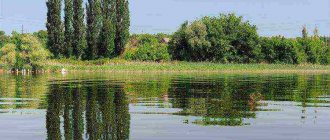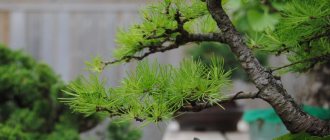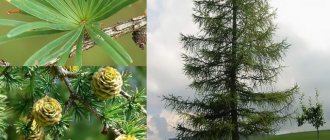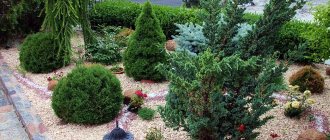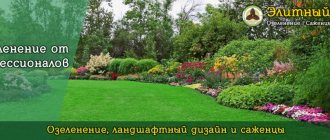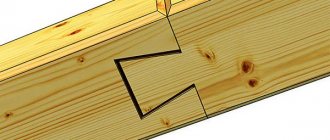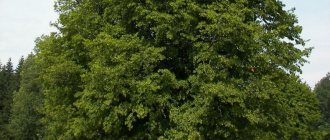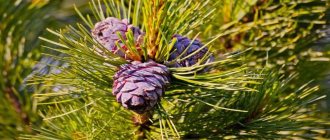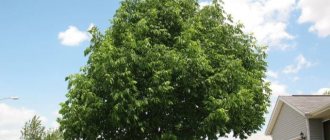What does larch look like?
This tree belongs to monoecious coniferous plants from the pine family. Its distinctive feature from other members of the family is the shedding of needles every year. Habitat: European continent, Asia and America. Prefers to grow in cold, temperate climates, less often in the subtropical zone.
This is what larch needles look like
What does a larch tree look like? Under natural conditions, it can reach 50 m in height. The trunk is thick, covered with brown bark with deep grooves. Old trees boast trunks reaching a meter in diameter.
Larch crown shape
The shape of the larch crown tends to change as the plant grows. Thus, in young trees the crown is distinguished by its peculiar lightness and a certain delicacy. Initially, the branches are arranged in the form of a cone. As the plant matures, changes in the shape of the crown begin. Now it is more flattened at the top, and generally resembles an oval.
Note! In growing areas where winds often blow, bald spots form on the crown of the plant from the northern part.
Root system
The root system of larch in the wild is powerful. Characterized by branching without a pronounced tap root. At the same time, the lateral roots are strong and buried. This allows the tree to be stable in strong gusts of wind. In some cases, you can see the appearance of roots on branches that are in close contact with the ground.
In places with heavily waterlogged soil, the root system is a surface network. Adventitious roots are formed in a tree when it grows in wetlands (moss bogs, sandy-silty soils, when a layer of moss grows on the trunk).
Needle length
The needles of this tree are unusual: not prickly at all, painted bright green and flattened on both sides. The total length of the “needles” reaches 4 cm. Long branches, depending on the type of plant, are decorated with single needles or growing in the form of a spiral. On shorter branches, the needles are collected in peculiar bunches.
Larch cones
As stated in the description of larch, this type of conifer is a gymnosperm plant, and its fruits are cones. The fruiting phase (formation of cones on the tree) occurs late - approximately 10-15 years of the tree’s life. The shape of the cones and their size directly depend on the gender of the plant. In males, the fruits are covered with specific yellow scales and reach a size of 10 mm. Female plants have red cones (in some cases bright scarlet). The size of female fruits is much smaller than male ones. As the seeds ripen, they fall out of the cones and are carried by the wind over fairly long distances.
Female cones
After the tree sheds its needles in the fall, it enters winter completely bare, but at the same time tolerates severe frosts well. In spring, new young green needles begin to grow.
Where does larch grow?
Weeping larch and other weeping trees for the garden
What kind of larch tree this is and where it is distributed is clearly explained by biologists. Its natural habitat is considered to be the subarctic and subalpine climatic zones. This representative of conifers grows in the mountainous regions of a number of Asian and European countries. Distributed in Canada and the northern states of America. It is capable of forming real light-coniferous forests. It also does well growing near other trees.
Note! Common larch is considered the most numerous tree species not only in Russia, but throughout the world.
How many years does larch live?
The lifespan of this tree is on average 350 to 450 years. But there are recorded cases of representatives of this breed living for 900 years. Long-lived species of larch include Siberian, European, Daurian, and Japanese larch.
Sinister Legends
Many legends have long developed around aspen, and peasants and ordinary people openly disliked it. The tree was not planted next to houses, nor was it hidden in its liquid shadow. What is the reason for the people's hostility? It is unsuitable for farming: aspen burns poorly, does not provide enough heat, and is prone to rapid rotting. But there were also mystical reasons: according to the legendary biblical parable, the traitor Judas hanged himself on an aspen tree; the cross for the crucifixion of Jesus was also made of aspen. Therefore, it was considered a cursed tree that trembles even without wind. It's true: aspen leaves are almost always in motion, but biologists explain this fact by the special sensitivity of delicate leaves.
But this attitude is unfair. Indeed, at the same time, ancient people cast out evil spirits with a sharpened aspen stake, looked for thieves with the help of an aspen rod, and used clean water from aspen wells.
What happens to a tree in winter
Thuja - tree, what it looks like, varieties and varieties
The tree tolerates the cold season well. It is resistant to short frosts after winter, as well as temperature changes in winter. In this regard, it is widespread and grows in the Arctic Circle and in the highlands.
Japanese larch
Attitude to light
This is a light-loving plant, so the best growth is observed during the period of full sunlight. Despite the fact that it is equipped not with leaves, but with needles, it is in the presence of bright lighting that its best renewal and growth occurs.
Over a long period of time (several decades), the growth is insignificant due to shading by the parent tree stand. Favorable conditions for growth are unshaded areas of the forest. With good lighting and suitable soil, the young tree grows quickly, adding up to 1 meter per year until it is 20 years old.
Long-lived in the northern hemisphere
And now we will talk about the berry yew, a long-lived tree, since its age reaches 4 thousand years. Previously, it was common in Western Europe, Asia Minor, and the Caucasus. But people quickly destroyed this unique tree. Its wood is practically eternal and has antibacterial properties.
Houses that only had yew ceiling beams could be saved from pandemics, as the wonderful wood prevents the growth of bacteria even in the air.
Larch is a coniferous or deciduous tree
Evergreen cypress - what it is and what it looks like
What is larch? It is a genus of plants belonging to the pine family. Larch is a coniferous tree that loses its needles during the winter and grows them back with the onset of spring warmth.
Interesting facts about larch
In addition to the fact that the larch tree has the ability to shed its needles for the winter, it has a number of interesting features. For example, its wood of a pleasant golden hue with a beautiful texture is very hard and elastic, and has good resistance to rotting processes.
Larch forest
People learned to extract dyes from the bark and use them to process fabrics. Interior items (furniture) made from this type of coniferous wood have the ability to purify the air from harmful substances present in it. The phytoncides contained in wood help to quickly cope with cold-type diseases.
Note! People suffering from high blood pressure are recommended to purchase interior items made from larch. Phytoncides entering the air have a pronounced effect on blood vessels, reducing pressure.
Aspen assistant
The modern use of aspen is quite wide. In addition to being planted in park areas, aspen is used to paint products, process leather, make containers, matches and plywood. Aspen log cabins are also in demand. Aspen “liquid smoke” is used for marinades and smoking foods. It also has numerous medicinal properties, which are highly valued by traditional medicine.
This merciful tree with thin bark saves many forest inhabitants in the winter cold, being their only food.
How to distinguish larch from pine
In the wild, distinguishing pine from larch is not difficult. Especially in winter, because larch sheds its needles, unlike its relative pine. The difference is in the growth itself. Pine needles are long, sparsely located on the branches, and prickly. Larch has soft needles, flattened on both sides.
Problems with differences may arise when using wood materials. To distinguish pine from larch, you need to take into account a number of features of each of the presented tree species. Main criteria and differences:
- Smell – pine boards have a bright coniferous smell, while larch boards have an almost imperceptible aroma.
- Color characteristics - sawn larch has a dark tint, and under the influence of direct sunlight it becomes reddish. Pine wood is light-colored, later acquiring a yellowish tint.
- Weight – larch is much denser and heavier than pine.
- Strength and fire resistance - when running a sharp object across larch wood, no traces are left, unlike a similar experiment with pine wood. In addition, pine ignites faster, so it is preferable to choose larch for construction and finishing of premises.
Yew hunting
Yew wood was used not only for construction. Furniture began to be made from yew, and even later the expensive wood was used to make sacred objects and caskets for storing relics. The unique material perfectly preserved them from damage. Only very noble people could afford yew boxes. This uniqueness has served the yew berry poorly: it is rarely found in nature, and is mainly found in cultivars.
It is now widely used in topiary art, especially in the United Kingdom. In green construction, borders, labyrinths, and various shapes are made from yew.
If you compare how long Siberian larch, aspen, and yew live (500 years, 90 years and 4 thousand years, respectively), it seems that this is a very long time. But these unique trees are threatened with extinction if people do not come to their senses and save them from extermination.
Use in landscape design
The northern coniferous beauty has about 20 species. To decorate local areas, breeding specialists have developed numerous decorative varieties.
Larch in the landscape
Guided by simple planting rules, you can root a plant either alone in the middle of the lawn or make it part of a composition in your garden plot. To highlight the beauty of this coniferous tree, various deciduous plants and groups of shrubs are used in the garden. Larch looks good in a rock garden.
The most attractive tree is a standard tree, the branches of which hang down in the form of a cascade. It looks beautiful near lampposts and garden paths. Landscape designers also recommend covering the area near the tree with small pebbles. It is important to remember that this representative of conifers does not like wetlands.
Popular varieties
The most popular and famous varieties of larch:
- European;
- Siberian;
- Daurskaya;
- Sukacheva (Russian);
- Kurilskaya;
- Far Eastern;
- Polish;
- American.
Video: Caring for larch, varieties of larch
Cultivated plant species in Russia are Polish and Japanese larch. They can often be found in botanical gardens, parks, and private plots.
Application of larch in construction
Wood is used quite widely in construction. Due to the recent increase in fashion for wooden houses, it is recommended to choose larch for logs and beams for them. Walls made of this type of coniferous wood do not allow cold air and extraneous noise into the room.
Note! Larch wood can fill a room with a pleasant aroma, which many associate with cleanliness.
I use larch wood for the construction of classic houses or as a complement to buildings built from brick and stone. Due to the fact that this species of coniferous trees has an unusually low thermal conductivity, it is used to build baths and saunas. In addition, substances contained in wood block the formation of fungi and destroy pathogenic bacteria. Larch wood is even more often used to make furniture, as well as floors, stairs, window frames and doors.
The disadvantages of wood during work are:
- increased complexity in processing the material - the tool quickly deteriorates;
- problems with renewing wood coverings due to the high hardness of the wood species;
- drying problems;
- the appearance of cracks over time as a result of frequent and uneven wetting of lumber.
Larch is a real miracle of nature. Despite the fact that it belongs to the coniferous tree species, it has a distinctive feature - it sheds its needles for the winter. The tree trunk is so strong that it can stand for centuries. After all, it was from Siberian larch that the piles on which Venice still stands were made.
Coffee capsule Nescafe Dolce Gusto Chocochino, 3 packs of 16 capsules
1305 ₽ More details
Hot chocolate capsules Nescafe Dolce Gusto Chococino, 8 servings
334 ₽ More details
Profiles for LED strip
Features of cultivation
It is better to use standard planting material . If you grow it yourself, seedlings sprouted in compost with sand and enriched with phosphorus and potassium fertilizers will be of much better quality. Sow in late autumn in boxes, grow for 1–2 years, take outside in the spring, watering is required.
In addition to proper agricultural technology and preventive measures against diseases of a grown tree, it is important to fertilize the soil, thanks to this the larches will grow faster and become stronger . In autumn, fertilizing includes superphosphates, which must be used in dry form (scattered around the perimeter of conifers, the trees are watered). They don't cover it for the winter.
Important! The plant does not survive transplantation well, so seeds are used to grow it.
Larch is distinguished by its endurance and ease of care. It is very beautiful in early spring and late autumn: in spring the needles acquire a soft green tint, and in autumn they become bright yellow. If you need to decorate your garden with something unusual, pay attention to larch.
